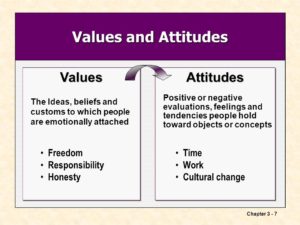Values and attitudes are a basic part of human behaviour. Values are our gut level beliefs about what is right or wrong, good or bad, normal or abnormal.
Generally, value has been taken to mean moral ideas, general conceptions or orientations towards the world or sometimes simply interests, attitudes, preferences, needs, sentiments and dispositions.
According to M. Haralambos, “A value is a belief that something is good and desirable”.
The Characteristics of Values are:
- These are extremely practical, and valuation requires not just techniques but also an understanding of the strategic context.
- These can provide standards of competence and morality.
- These can go beyond specific situations or persons.
- Personal values can be influenced by culture, tradition, and a combination of internal and external factors.
- These are relatively permanent.
- These are more central to the core of a person.
- Most of our core values are learned early in life from family, friends, neighborhood school, the mass print, visual media and other sources within the society.
- Values are loaded with effective thoughts about ideas, objects, behavior, etc.
Types of Values:
There are two types of values:
- Terminal Values.
- Instrumental Values.
An attitude may be defined as a tendency to react positively or negatively in regard to an object.An attitude is always directed toward some object. The object may be of general social significance, such as labour-management relations, or it may be purely personal.

There are differences between values and attitudes. Attitudes essentially represent predisposition to respond. Values focus on the judgment of what ought to be.Attitudes represent several beliefs focussed on a specific object or situation.Value,on the other hand, represents a single belief that transcendentally guides actions and judgments across objects and situations.
Characteristics of Attitudes :
Attitude can be characterized by their –
- Valence
- Multiplexity
- Relation to needs
- Centrality.
1.Valence: It refers to the magnitude or degree of favorableness or unfavourableness toward the object/event. While measuring the attitudes we are basically concerned with the valence. If a person is relatively indifferent toward an object then his attitude has low valence. On the other hand, if a person is extremely favorable or unfavorable toward and attitude object, then his attitude will have a high valence.
2.Multiplexity: It refers to the number of elements constituting the attitude. For example, one student may show interest in studies, but another not only shows interest, but also works hard, is sincere, and serious. Similarly an employee may feel simply loyal to an Organisation, but another may feel loyal, respectful, fearful and dependent.
3.Relation to needs: Attitudes vary in relation to needs they serve. For instance, attitudes of an individual toward the pictures may serve only entertainment needs. On the other hand, attitudes of an individual toward task may serve strong needs for security, achievement, recognition, and satisfaction.
4.Centrality: One salient characteristic of the attitude refers to the importance of the attitude object to the individual. The centrality indicates the importance of the object. The attitudes that have high centrality for an individual will be less susceptible to change.
Attitude Formation: The sources of a person’s attitude are a mixture of
- Personal experiences
- Association
- Family
- Peer groups and society
- Models and
- Institutional factors
